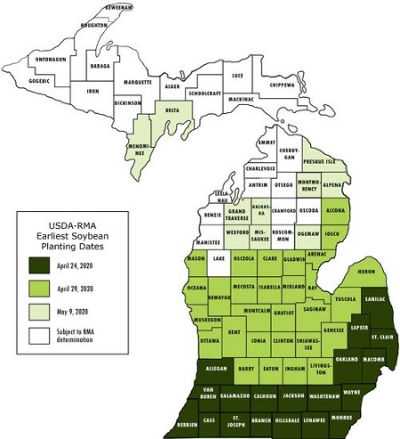By Michael Staton and Horst Bohner
Some soybean producers in Michigan are experimenting with ultra-early planting dates (late March to mid-April) with positive results. To date, research trials have not shown a consistent yield benefit to planting this early when compared to planting during the last week of April or the first week of May. We saw this in replicated on-farm trials conducted in Michigan in 2019 where ultra-early planting increased yield by 6.5 bushels per acre at one location but didn’t affect yield at two other sites. Given this, the main benefit of this practice is that it enables producers to extend the planting window by taking advantage of good soil and weather conditions that might occur in early to mid-April. Planting soybeans ultra-early carries some risk. We’ve listed the risks associated with ultra-early planting and how to mitigate them in this article.

Figure 1. Risk Management Agency’s (RMA) earliest planting dates for soybeans in Michigan.
Imbibitional chilling injury
This condition occurs when the soybean seed imbibes very cold water in the first 12 to 24 hours after planting. Rainfall events occurring within 24 hours of planting favor imbibitional chilling injury. This is likely because a cold rain immediately following planting shocks the seedling with a rapid intake of cold water. Cool soil temperatures can prevail without causing significant chilling injury if the seed quality is good and the soil is not saturated. Visible symptoms of imbibitional chilling injury include uneven emergence and dead tissue on the exterior of the cotyledons. Management practices that will reduce the potential for imbibitional chilling injury are listed below.
- Plant in the early afternoon to allow soils to warm up.
- Avoid planting when rain is imminent within 24 hours after planting. The heavy rain events that occurred in April and early May 2017 adversely affected soybean germination and emergence in many early planted fields in 2017.
- Plant high quality seed having intact seed coats that are free of wrinkles or growth cracks.
- Avoid planting seed having low initial moisture levels.
Seedling diseases and poor plant stands
Due to the high probability that very early planted seed will be confronted with cool and wet soils, Michigan State University Extension recommends using fungicide seed treatments when planting early. Select fungicides that are effective against fusarium, pythium, phytophthora and rhizoctonia. Producers should also select varieties that are resistant/tolerant to sudden death syndrome and phytophthora when planting very early. Early planted seed is often in the ground much longer than late planted seed, giving more time for diseases to invade the seedling. A good fungicide seed treatment will reduce the risk of poor plant stands.
Frost or freeze damage
One of the leading risks of very early planting is that emerged plants will be damaged by freezing temperatures as the growing point is exposed and vulnerable when the cotyledons emerge. This risk is mitigated to some degree by the fact that germination and emergence are delayed under cooler soil temperatures. Soybean tissue is also more resistant to freezing temperatures than corn tissue.
Typically, temperatures must reach 29-30 degrees Fahrenheit for damage to occur to emerged beans before the first trifoliate leaves emerge. Once the first trifoliate leaves develop, the plants become susceptible to damage from temperatures at or below 32 F. Planting in fields at higher elevations having good air drainage will reduce the risk. Removing residue from the row is a mixed bag for very early planting. It will cause the soil to warm up sooner and promote earlier germination and emergence, which may expose the emerged plants to greater risk of frost or freeze injury.
Shortened reproductive period
A less probable risk is that abnormally warm weather may occur after planting, causing the plants to emerge in April. Even if the emerged plants escape frost or freeze injury, the unifoliate leaves will sense the shorter photoperiod occurring at this time of the year, causing the plants to flower significantly earlier than normal and potentially shortening the reproductive period. Planting the latest maturing varieties that are adapted to the area will reduce the impact of this outcome.
Reduced yield from plants maturing too early in the fall
If the first part of summer is dry, early planted fields may mature too rapidly in the fall, missing late season rains. Late summer rains can significantly increase yield unless the plant is already past the R6 growth stage. The best way to mitigate this problem is to plant varieties that are the latest maturing variety adapted for your area. Planting early maturing varieties very early in the spring may reduce yields.
Bean leaf beetles
The potential for damage from bean leaf beetles is increased by early planting as the beetles congregate on the earliest emerging soybean fields in a given area. Watch for bean leaf beetle feeding and apply an insecticide if damage exceeds the treatment threshold (50% defoliation on seedlings).
Federal crop insurance
Planting soybeans prior to the Risk Management Agency’s (RMA) earliest planting dates listed in Figure 1 will make you ineligible for replant coverage (if you carry yield protection except for catastrophic risk protection, or revenue protection). However, your harvest guarantee and prevent plant coverage is not adversely affected when planting before the earliest planting date. Under the federal crop insurance program, payment for replant on soybeans is calculated as 3 bushels x projected price = payment per acre.
Ultra-early soybean planting offers potential benefits but also poses risks. Public and private research trials will be conducted in 2020 to assess this practice. If you want to experiment with ultra-early planting, take the recommended steps mentioned above to help reduce these risks.
Source : msu.edu